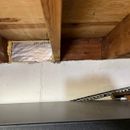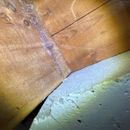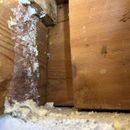I recently had an energy audit/blower door test on my 1963 single-story ranch home near Detroit, Michigan in zone 6A. The auditor noted cold air infiltration along some baseboards, and recommended pro sprayfoaming the rim joist to about 3 inches total over the existing (1.5″ thermax+ canned great stuff) DIY job I did 5 years ago).
In doing some research, I realized that my house doesn’t have a sill plate or capillary break; the joists sit directly on the poured concrete foundation wall.
The sprayfoam company I had out for an estimate told me not to worry about this, but I’ve read a lot of threads here and elsewhere (like this comprehensive reddit post: https://www.reddit.com/r/HomeImprovement/comments/sue5xm/insulating_rim_joist_with_no_sill_plate_for/) saying that closed cell foam could lead to moisture and rotten joists in this situation. FWIW I removed a few sections of the thermax I’d added to check things out, but I don’t see any signs of moisture damage.
Outside grade is about 7 inches below where the bottom of the joists sit on top of the poured foundation inside, and there haven’t been any water intrusion issues in the basement.
The first two attached images show a wide view of a rim joist bay with my DIY insulation job next to one where I’ve removed the insulation, as well as a closer shot showing no moisture damage in the cleaned out bay.
The baseboard air leaks were the worst along the North wall end joist (running parallel to the other floor joists/north foundation wall). I also tore off some of my DIY job there, and found lengths of 2×6 along that wall sistered inside the end joist. Guessing these are just for floor nailers, but again, no sign of moisture damage. It seems like the gaps I left in between the sistered pieces under my foam board could have been the primary cause of those drafts.
The last 3 attached images show some of the gaps around these sistered boards on the north end joist: the fist is in the NE corner, and the other two are sections along the wall.
My questions:
– Am I right in thinking that having the whole rim joist pro sprayfoamed is a bad idea?
– If so, is my DIY canned great stuff and thermax job OK? Again, not seeing any issues at this point.
– How should I handle the gaps where the end joist has sections that are sistered in that drafty North wall? Would it make sense to just redo my DIY work here, maybe caulking all the edges first *before* putting in the foam board and great stuff, or is there something else that would work better?
Thank you for any advice!














Replies
Dropping a comment so I can receive updates on this thread :) I am in a similar boat, 1966 house across the pond from you in Ontario. I haven't done any work yet but in the winter I definitely feel some significant cold air drafts coming from the rim joist area...
sonoflee, tkzz,
Threads with similar questions often have trouble eliciting responses, I think because it's hard to know what puts these assemblies over the edge. They work because there is good air movement and heat to keep the wood dry. How much air-sealing and insulating you can do before they become risky is very case dependent.
There are two sure-fire cures, which unfortunately are both quite disruptive:
You can jack the rim-joist up very slightly a bit at a time, and install a vapour-barrier on top of the concrete. That leaves you free to insulate with either spray foam or foam board with much less worry.
You can also insulate the rim-joist on the outside, which means it will stay warm enough to avoid rot.